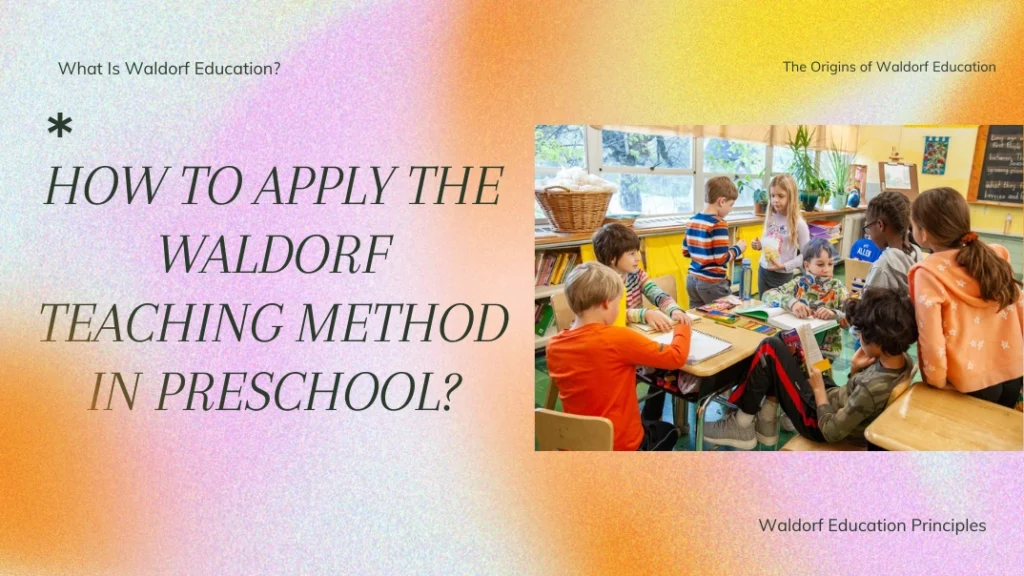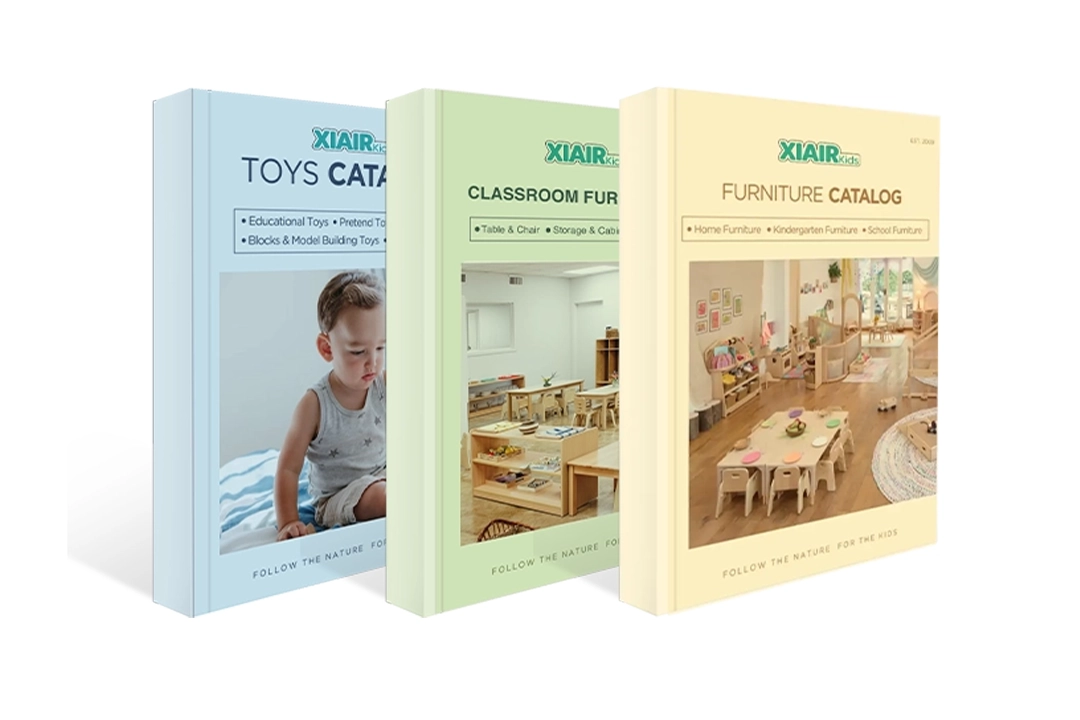اكتسبت طريقة والدورف التعليمية زخمًا كبيرًا عالميًا، لا سيما في بيئات ما قبل المدرسة حيث تُعطى الأولوية لتنمية الطفل الشاملة. ولكن ما هي بالضبط تعليم والدورفوكيف يُمكن تطبيق منهج والدورف بفعالية في رياض الأطفال؟ يتميز هذا المنهج بتركيزه الفريد على تنمية الطفل ككل - عقلًا وجسدًا وروحًا - وتأكيده على الإبداع والاستقلالية والتواصل مع الطبيعة. ستُطلعك هذه المقالة على مبادئ تعليم والدورف، وإيجابياته وسلبياته، وكيفية دمج منهجياته في صفك الدراسي.
أسلوب والدورف التعليمي، المستمد من فلسفة رودولف شتاينر التربوية، يُعطي الأولوية للتعلم التجريبي، وتنمية الإبداع، وتعميق العلاقة مع الطبيعة. بدمج تعليم والدورف في مرحلة ما قبل المدرسة، يتلقى الأطفال إعدادًا أكاديميًا، ويُربون ليصبحوا مفكرين مبدعين، وأفرادًا مسؤولين، ومتعلمين مدى الحياة.
تتميز طريقة والدورف التعليمية عن التعليم التقليدي بتوفير نهج أكثر توازناً وشمولية لتعلم الأطفال. من خلال منهجية والدورف التعليمية، يستمتع الأطفال ببيئة تعليمية غنية تشمل المواد الأكاديمية والفنون والمهارات العملية والتطور الشخصي. ومع ذلك، يجب على المعلمين وأولياء الأمور إدراك أن تطبيق طريقة والدورف التعليمية يتطلب الالتزام بمبادئها الأساسية.
But how does the Waldorf Teaching Method differ from traditional models, and how can it be integrated into early childhood settings? Let’s begin by exploring what Waldorf education truly is.
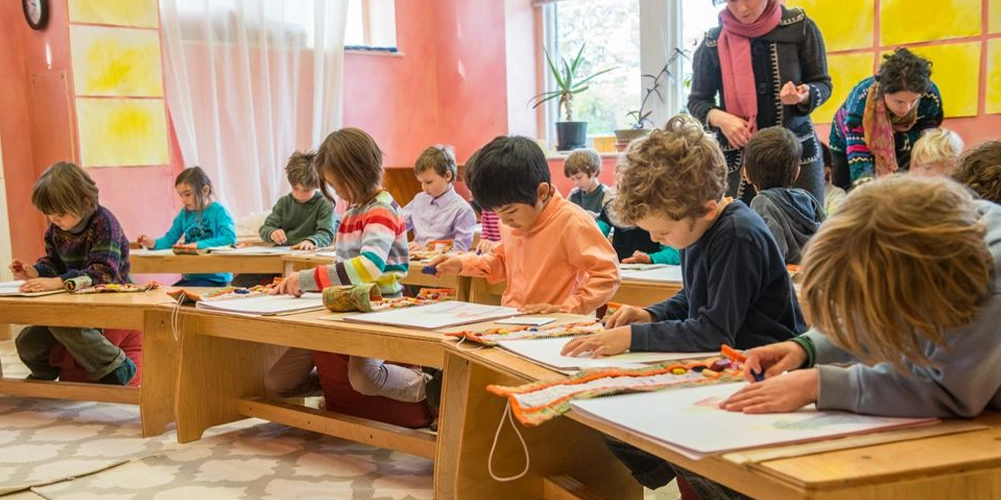
مقدمة
The Waldorf Teaching Method is known for its creative, child-focused approach to learning. Rooted in the ideas of Rudolf Steiner, Waldorf education is practiced in schools and kindergartens around the world. Unlike traditional classrooms, Waldorf schools value hands-on experiences, a strong sense of rhythm, and a close connection to nature. This unique way of teaching has inspired many parents and teachers to look for new ways to support each child’s natural growth and love of learning. In the following sections, we’ll explore the main ideas and principles that make the Waldorf approach so special.
Waldorf Teaching Method: Foundations and Core Principles
The Waldorf Teaching Method believes that children learn best when their mind, body, and emotions are supported together. Started by Rudolf Steiner, this approach sees every child as unique, going through different stages as they grow. In Waldorf classrooms, learning is hands-on and creative, with lots of time for play, art, and exploring nature. A steady daily and seasonal rhythm helps kids feel secure. Teachers respect each child’s pace and adjust lessons to fit the class. These simple but powerful ideas make the Waldorf Teaching Method stand out from traditional education.
Who Is Rudolf Steiner?
رودولف شتاينر was an Austrian philosopher, social reformer, and educator best known for founding the Waldorf education movement. Steiner believed that education should nurture every part of a child’s mind, body, and spirit. His ideas shaped what is now called the Waldorf Teaching Method, or Steiner education, which is practiced in many Waldorf schools around the world. Steiner’s philosophy, known as anthroposophy, is at the heart of all Waldorf education principles.
Today, Steiner and Waldorf education are closely linked. Many Waldorf teachers, parents, and schools still study Steiner’s lectures and writings to understand the unique characteristics of this approach better. The Waldorf system encourages creativity, individuality, and a strong sense of connection with the world—a vision first set out by Rudolf Steiner over a century ago.
Because of Steiner’s influence, Waldorf schools have grown globally, including in the United States, Europe, and Asia. Rudolf Steiner’s vision of education, now called the Steiner Waldorf approach, is known for blending academic subjects with the arts, practical activities, and a respect for childhood development.
ما هو تعليم والدورف؟
Waldorf education, sometimes called the Waldorf Teaching Method or Steiner education, is a way of teaching that focuses on the whole child. This method is used in Waldorf schools, Waldorf kindergartens, and even public Waldorf education programs. At its core, Waldorf education encourages children to learn by doing, with lots of play, art, music, and hands-on activities.
The Waldorf classroom looks and feels different from traditional schools. There are often wooden toys, natural materials, and creative spaces for children to explore. The curriculum follows the natural stages of childhood and values each child’s pace. This unique learning environment is one of the defining features of Waldorf pedagogy and what sets the Waldorf method apart from other education systems.
Families are drawn to the Waldorf approach because it emphasizes imagination, practical skills, and a love for learning that lasts a lifetime. The Waldorf education philosophy respects the importance of routine, rhythm, and a strong connection between home and school. Today, there are thousands of Waldorf schools and Steiner schools worldwide, each dedicated to helping children grow into thoughtful, confident, and compassionate adults.
لا تحلم فقط، بل صممه! دعنا نتحدث عن احتياجاتك من الأثاث المخصص!
أصول تعليم والدورف
تأسست أول مدرسة والدورف عام ١٩١٩ لأبناء عمال مصنع سجائر والدورف أستوريا في شتوتغارت، ألمانيا. تصوّر رودولف شتاينر نظامًا تعليميًا يُنمّي القدرات الفكرية والقدرات الفنية والعملية والأخلاقية للطلاب. صُمّم نظام والدورف التعليمي ليكون ديناميكيًا ومرنًا، مما يتيح للمعلمين حرية إعداد دروس مُصمّمة خصيصًا لمراحل نموّ طلابهم. كان الهدف تنشئة أفراد متكاملين قادرين على المساهمة بفعالية في المجتمع.
منذ ذلك الحين، اتسع نطاق تعليم شتاينر وفالدورف عالميًا، حيث تعمل آلاف مدارس والدورف حول العالم. تُطبّق كل مدرسة من مدارس والدورف أسلوب والدورف التعليمي من خلال تكييف مبادئ شتاينر بما يتناسب مع السياقات الثقافية والجغرافية والاجتماعية لطلابها. وسواءً في المدارس الريفية أو الحضرية، يُركّز منهج والدورف على تنمية الطفل من خلال الأنشطة الأكاديمية وغير الأكاديمية.
اليوم، تمتد مدارس والدورف التعليمية عبر قارات متعددة، وتقدم تعليمًا من مرحلة ما قبل المدرسة وحتى المرحلة الثانوية. وتواصل هذه المدارس اتباع المبادئ التي وضعها رودلف شتاينر، مع التركيز على النمو الشامل لكل طفل.

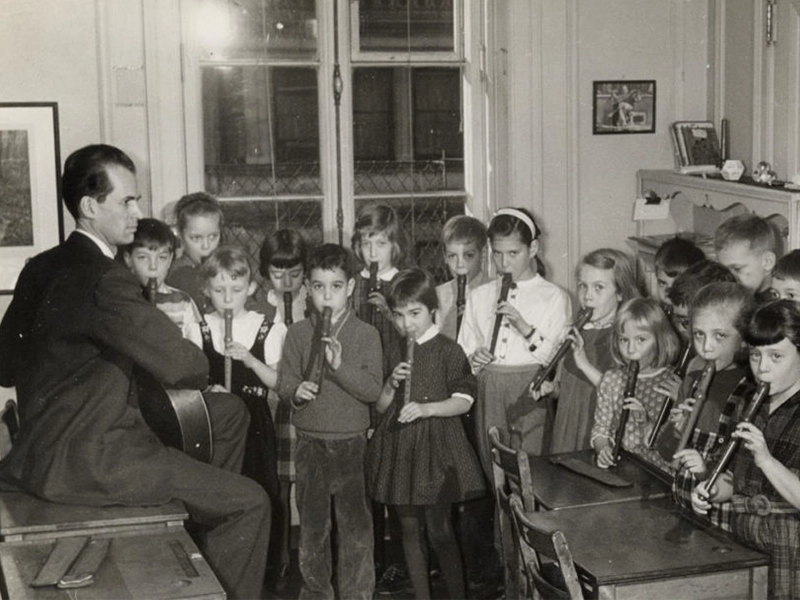
أسس تعليم والدورف
يعتمد تعليم والدورف على الاعتقاد بأن الأطفال يمرون بثلاث مراحل نمو مميزة: الطفولة المبكرة، والطفولة الوسطى، والمراهقة. تتميز كل مرحلة من هذه المراحل باحتياجات نمو محددة، والتي يُعالجها منهج والدورف بما يدعم نمو الطفل الطبيعي وقدرته على التعلم.
الطفولة المبكرة
في مرحلة الطفولة المبكرة، يُركز تعليم والدورف على التعلم من خلال اللعب والتقليد والتجارب الحسية. صُممت بيئة صف والدورف الدراسية لتكون بسيطة ومُزودة بالمواد الطبيعية، مثل الألعاب الخشبية والصوف، مما يُعزز التواصل مع الطبيعة. تُتيح هذه المرحلة من تعليم والدورف للأطفال تنمية أجسامهم وحواسهم من خلال مهام هادفة كالطبخ والتنظيف والبستنة.
تشمل الجوانب المهمة لمنهج ما قبل المدرسة في مدرسة والدورف ما يلي:
- اللعب الإبداعي: Play-based learning is the cornerstone of Waldorf pedagogy at this stage. Children are encouraged to engage in imaginative play with simple, natural toys that inspire creativity.
- رواية القصص والإيقاع:تشكل القصص الشفهية والأغاني والأبيات الشعرية عنصراً أساسياً في الأنشطة اليومية، حيث توفر بنية إيقاعية تمنح الأطفال شعوراً بالأمان.
- مهارات الحياة العملية:يشارك الأطفال في مهام مثل خبز الخبز، وتنظيف الفصل الدراسي، والزراعة في الحديقة، مما يساعد على تطوير المهارات الحركية وتعزيز الاستقلال.
تُركّز طريقة والدورف التعليمية على تنمية قدرات الأطفال الجسدية والعاطفية والتخيلية خلال هذه المرحلة. من خلال المهام العملية واللعب، يختبر الأطفال العالم من حولهم ويطورون مهارات أساسية تدعم التعلم الأكاديمي المستقبلي. يُخلو فصل والدورف الدراسي في هذه المرحلة عمدًا من الأجهزة والشاشات عالية التقنية، وهو ما يتماشى مع فلسفة والدورف التي تدعو إلى تفاعل الأطفال بشكل مباشر مع محيطهم.
In a Waldorf preschool, the teacher plays a crucial role in modeling behaviors for the children to imitate. This highlights another fundamental principle of the Waldorf Teaching Method: children learn best through example, not through direct instruction at such an early stage. Waldorf classrooms are often described as serene and nurturing spaces, encouraging imaginative play and exploration.
مرحلة الطفولة الوسطى
في مدارس والدورف، يبدأ التعلم الفكري بالتبلور في مرحلة الطفولة المتوسطة. ومع ذلك، وتماشيًا مع فلسفة شتاينر، لا يزال أسلوب والدورف التعليمي يُركز على التعلم التجريبي والتعبير الفني كأداتين أساسيتين للتطور الفكري.
تتضمن العناصر الرئيسية لمنهج والدورف لهذه المرحلة ما يلي:
- كتل الدرس الرئيسية:يتم تدريس المواد الأكاديمية مثل الرياضيات والأدب والعلوم في مجموعات مكثفة تستمر لعدة أسابيع، مما يسمح للطلاب بالانغماس بشكل كامل في الموضوع.
- التكامل الفني:يتم تدريس كل مادة في فصول والدورف من خلال الأساليب الفنية - يتم استخدام الرسم والتلوين ورواية القصص والدراما لجعل الأفكار المعقدة أكثر واقعية وقابلة للربط.
- الأنشطة العملية: In line with the Waldorf philosophy, children also engage in practical tasks, such as handicrafts and woodworking, that integrate cognitive and physical skills.
خلال هذه المرحلة، تعمل فلسفة مدرسة والدورف على تعزيز تنمية الذكاء العاطفي، مع التركيز على الإبداع والخيال والتعاون.
يساعد أسلوب والدورف التعليمي خلال مرحلة الطفولة المتوسطة الأطفال على النمو عاطفيًا وفكريًا، مما يُهيئهم للمتطلبات الأكاديمية الأكثر صرامة في مرحلة المراهقة. ومن المعروف أن المعلمين في مدارس والدورف يبقون مع نفس المجموعة من الطلاب لعدة سنوات، مما يُعزز علاقات قوية قائمة على الثقة، مما يُسهم في بيئة تعليمية مستقرة. تُعدّ هذه الاستمرارية سمة أساسية لنظام والدورف التعليمي، مما يُميزه عن المدارس التقليدية التي يغيّر فيها الطلاب معلميهم باستمرار.
يُركّز تعليم والدورف أيضًا على اللعب في الهواء الطلق والتواصل مع الطبيعة خلال مرحلة الطفولة المتوسطة. وتُدمج الأنشطة الخارجية اليومية، والنزهات في الطبيعة، والرحلات الميدانية في منهج والدورف لمساعدة الأطفال على التواصل مع بيئتهم، مما يعكس القيم الأساسية لمدارس والدورف.
مراهقة
مع انتقال الأطفال إلى مرحلة المراهقة، ينتقل منهج والدورف إلى تعزيز التفكير النقدي والتأمل الأخلاقي والمسؤولية الاجتماعية. تُركّز مدارس والدورف في هذه المرحلة على التعلم المستقل والمشاركة المجتمعية والسعي وراء الاهتمامات الشخصية.
وتتضمن الجوانب الرئيسية لهذه المرحلة ما يلي:
- التفكير النقدي:يتم تشجيع المراهقين على المشاركة في المناقشات الفلسفية ومشاريع البحث والمهام التحليلية لتطوير قدراتهم على التفكير والتأمل.
- التعلم من خلال الخدمة:تماشياً مع مبادئ والدورف، يشارك الطلاب في مشاريع الخدمة المجتمعية التي تؤكد على المسؤولية الاجتماعية والوعي الأخلاقي.
At this stage, the Waldorf Teaching Method helps adolescents understand their role within the community and the wider world. Waldorf teachers become mentors, supporting students in developing independence and a strong sense of purpose.
في مدارس والدورفالمراهقة هي مرحلة اكتشاف الذات والنمو الشخصي. صُمم المنهج الدراسي لتحفيز الطلاب فكريًا وعاطفيًا، وتوجيههم ليصبحوا أفرادًا متعاطفين ومفكرين، مستعدين للمساهمة الإيجابية في المجتمع. وتواصل مدارس والدورف التعليمية حول العالم تطبيق هذه المبادئ لضمان تخرج الطلاب بتعليم شامل يتجاوز مجرد التحصيل الأكاديمي.
فصلك الدراسي المثالي على بعد نقرة واحدة!
مبادئ تعليم والدورف
تُحدد فلسفة تعليم والدورف عدة مبادئ أساسية. تُوجه هذه المبادئ كيفية تفاعل المعلمين مع الطلاب، وتُشكل المنهج الدراسي لتعزيز تجربة تعليمية شاملة.
الإنسان ككائن روحي
من المعتقدات الأساسية في منهج والدورف التربوي أن الأطفال كائنات روحية ذات مصائر فريدة. يشجع أسلوب والدورف التعليمي النمو الروحي للطفل، ليس بالمعنى الديني، بل من خلال تنمية شعوره بالدهشة والاحترام للحياة. صُممت فصول والدورف لإثارة الإعجاب من خلال جمال المواد الطبيعية، والإيقاعات الموسمية، والتعبير الفني.
يتوافق أسلوب والدورف التعليمي بشكل وثيق مع إيقاعات العالم الطبيعي، حيث تُسهم الإيقاعات اليومية والأسبوعية والفصلية في تهيئة بيئة آمنة ومستقرة للأطفال الصغار. ففي روضة والدورف، على سبيل المثال، تُساعد الأغاني والأبيات الشعرية والأنشطة الموسمية الأطفال على التواصل مع مجرى الزمن الطبيعي. ويُركز الجانب الروحي لتعليم والدورف على تنمية إمكانات كل طفل الفريدة وشعوره بذاته، مما يُساعده على النمو ليصبح فردًا متعاطفًا ومسؤولًا اجتماعيًا.
الحرية في التدريس
في نظام والدورف، يُمنح المعلمون حريةً واسعةً في تقديم الدروس. ويتيح أسلوب والدورف التعليمي للمعلمين تكييف المناهج الدراسية مع احتياجات طلابهم واهتماماتهم، مما يضمن استمرار تفاعلهم وتفاعلهم. تُميز هذه الحرية الإبداعية مدارس والدورف عن أنظمة التعليم التقليدية، حيث تُقيد المناهج الجامدة تجارب التعلم الفردية.
يُمنح معلمو مدارس والدورف استقلاليةً تامةً لصياغة دروسٍ تُلهم الفضول والإبداع. ويستخدمون ملاحظاتهم حول نمو الأطفال لتوجيه محتوى وأساليب التدريس. تتيح هذه الحرية للمعلمين في مدارس والدورف تخصيص تجربة التعلم لكل طفل، مما يجعل التعليم عمليةً عضويةً ومتطورةً بدلاً من أن يكون عمليةً نمطيةً.
تثمن طريقة التدريس والدورف دور المعلم كمربي ومرشد إبداعي، مما يسمح ببيئات تعليمية ديناميكية ومتجاوبة تشجع الطلاب على استكشاف اهتماماتهم ومواهبهم.
التعلم التجريبي وبناء العلاقات
يُولي نظام والدورف التعليمي الأولوية للتعلم التجريبي، حيث يتفاعل الأطفال مع المواد الدراسية من خلال أنشطة عملية. سواءً في الرسم أو البستنة أو رواية القصص، يتعلم الطلاب في فصول والدورف بالممارسة. إضافةً إلى ذلك، تُعدّ العلاقة الوثيقة بين المعلم والطالب سمةً مميزةً أخرى لمنهج والدورف التعليمي. غالبًا ما يبقى المعلمون مع نفس المجموعة من الطلاب لعدة سنوات، مما يُعزز الروابط الوثيقة التي تُعزز تجربة التعلم.
تُولي طريقة والدورف التعليمية أهمية بالغة للعلاقات التي تتشكل داخل الفصل الدراسي. فوجود معلم واحد يُرشد الطلاب على مدار عدة سنوات يُبني رابطة قوية من الثقة والتفاهم، ويخلق بيئة داعمة يشعر فيها الطلاب بالأمان للتعبير عن أنفسهم والمخاطرة في تعلمهم. هذه الاستمرارية أساسية لنظام والدورف التعليمي، إذ تُعزز الاستقرار والأمان العاطفي طوال رحلة الطفل الدراسية.
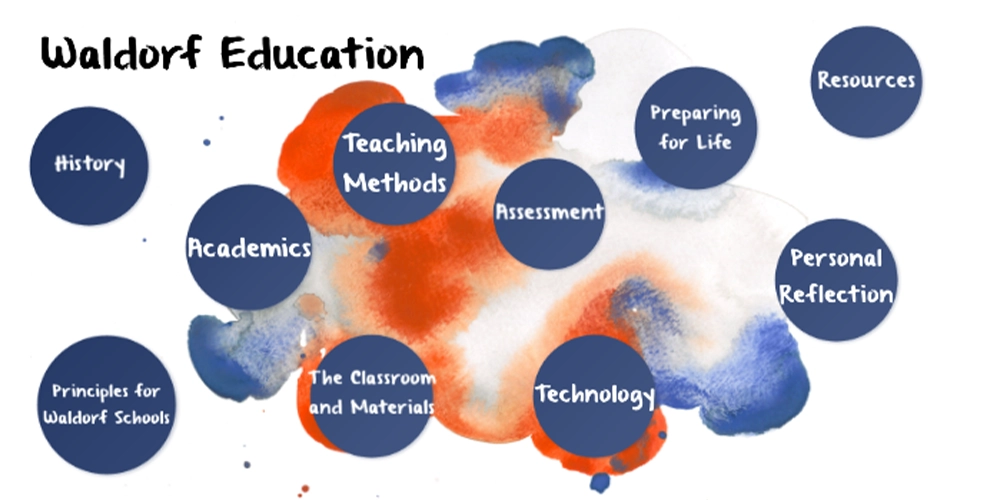
إيجابيات وسلبيات طريقة التدريس والدورف
عند دراسة نظام والدورف التعليمي لمرحلة ما قبل المدرسة، يُعدّ تقييم نقاط قوته وتحدياته المحتملة أمرًا بالغ الأهمية. فيما يلي نظرة شاملة على إيجابيات وسلبيات نهج والدورف.
الايجابيات:
- التعلم عملي ومناسب للعمر
تركز طريقة التدريس والدورف على التعلم التجريبي واللمسي، مما يسمح للأطفال بالمشاركة في الأنشطة التي تتناسب مع مرحلة نموهم. - التعلم يعتمد على اللعب
يعد اللعب جانبًا حيويًا من التعلم في مدارس ما قبل المدرسة والدورف، حيث يعزز الإبداع والتطور المعرفي والمهارات الاجتماعية. - لا يتم استخدام التكنولوجيا في الفصول الدراسية.
يعمل نموذج تعليم والدورف بشكل متعمد على تقليل استخدام التكنولوجيا، وتشجيع الأطفال على التفاعل المباشر مع العالم من حولهم. - يتعلم الطلاب كيفية القيام بدور نشط في تعليمهم
تشجع طريقة والدورف الأطفال على أن يكونوا متعلمين ذاتيين، مما يعزز الاستقلال والفضول. - تنتج مدارس والدورف أفرادًا متكاملين.
يدعم النهج الشامل لتعليم والدورف تطوير القدرات الفكرية والعاطفية والفنية، مما يساعد الأطفال على أن يصبحوا أفراداً متكاملين. - يتمتع الأفراد المتعلمون في مدرسة والدورف بشغف مدى الحياة بالتعلم
غالبًا ما يحافظ خريجو مدارس والدورف على حب عميق للتعلم طوال حياتهم، حيث تغرس فلسفة والدورف الفضول والشعور بالدهشة.
السلبيات:
- عدم التركيز على الجانب الأكاديمي
- يزعم منتقدو نظام والدورف التعليمي أن التأخر في تقديم المواد الأكاديمية الرسمية، مثل القراءة والرياضيات، يمكن أن يضع الطلاب في وضع غير مؤات مقارنة بأقرانهم في البيئات التقليدية.
- المعلمون يقومون بتدريس نفس الأطفال لسنوات عديدة
- ورغم أن هذا الأمر يعزز العلاقات القوية، فإنه قد يحد من تعرض الطالب لأنماط ووجهات نظر تعليمية مختلفة.
- الاستخدام المحدود للتكنولوجيا
- على الرغم من أن العديد من الآباء يقدرون النهج الخالي من التكنولوجيا في تعليم والدورف، إلا أن آخرين يشعرون أن هذا النهج قد يترك الطلاب غير مستعدين لعالم تقوده التكنولوجيا.
Waldorf education schools are often criticized for their reluctance to incorporate technology into the classroom. While this is intended to foster deeper personal and creative engagement, some parents and educators worry that children in Waldorf schools may not develop the necessary digital literacy skills for the modern world. Despite this, many proponents of the Waldorf Teaching Method argue that focusing on creativity and problem-solving skills in Waldorf schools adequately prepares students for future challenges.

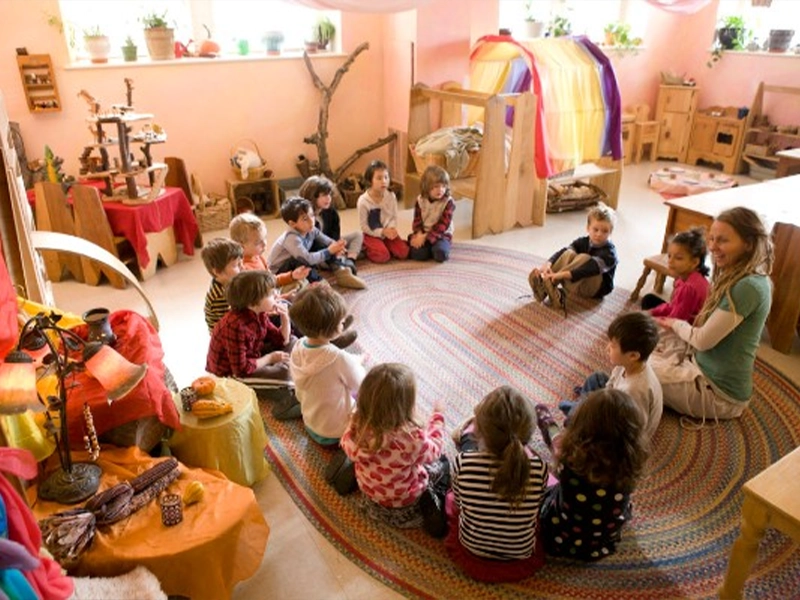
Creating a Waldorf-Inspired Learning Environment
A Waldorf-inspired classroom is carefully designed to reflect the heart of the Waldorf Teaching Method. Every detail—from the color of the walls to the choice of furniture—plays a role in supporting children’s learning and well-being. Let’s look at the most critical aspects of creating a space where Waldorf education can genuinely thrive.
Why the Classroom Environment Matters in Waldorf Education
In the Waldorf Teaching Method, the بيئة الفصل الدراسي is seen as an extension of the learning process. Waldorf schools understand that children absorb more than just what is taught—they are deeply influenced by their surroundings every day.
- The Classroom as the “Third Teacher”:
In Waldorf education, the physical classroom is not just a backdrop but an active part of the teaching team. The space gently guides children’s behavior and mindset. When a Waldorf classroom is organized with intention, it naturally supports focus, creativity, and collaboration among students. This is why many Waldorf schools invest in carefully planned layouts, soft lighting, and uncluttered areas. - Calm, Inviting Spaces:
Waldorf classrooms avoid loud colors or harsh lights. Instead, they feature gentle hues, natural sunlight, and plenty of quiet corners. This setting helps children feel safe and comfortable, which in turn encourages them to explore, ask questions, and try new things. A calm environment is a hallmark of Waldorf education and is closely connected to the success of the Waldorf teaching approach. - Movement and Flexibility:
Unlike traditional classrooms, a Waldorf classroom is not fixed. Furniture can be moved to make space for group work, circle time, or imaginative play. Flexible layouts promote both independence and cooperation. Children are invited to participate in arranging their classroom, which teaches responsibility and respect for shared spaces—a key value in Waldorf education schools. - Connection to the Senses:
Every element, from the texture of a wool rug to the scent of wooden shelves, is chosen to support children’s sensory development. The Waldorf learning method encourages teachers to use materials that invite touch and interaction. These sensory experiences ground children in the present moment and help them feel connected to their environment. - Supporting the Waldorf Curriculum:
A thoughtfully designed classroom supports all parts of the Waldorf curriculum. Whether it’s storytelling in a cozy corner, painting at a sunlit table, or gathering for morning songs, the environment enhances every learning experience. The Waldorf Teaching Method reminds us that children thrive when their classrooms are as nurturing and inspiring as the lessons themselves.
Choosing the Right Materials and Furniture for Waldorf Classrooms
Selecting the right furniture and materials is a key part of creating an authentic Waldorf classroom. The choices you make will shape not just the look and feel of the school but also how children learn and interact each day.
- Natural Materials at the Heart of Waldorf Design:
Waldorf schools and kindergartens prefer natural materials like wood, wool, and cotton for furniture and classroom items. Solid wood chairs, child-sized tables, and natural wooden shelves are common choices. These pieces are not only durable and safe but also help children connect with the natural world, a core idea in Waldorf education philosophy. You’ll often find wool rugs, cotton curtains, and handwoven baskets as well. - Child-Sized and Ergonomic Furniture:
The Waldorf Teaching Method values independence, so furniture is chosen with the child in mind. Look for low tables, small wooden chairs, open bookcases, and coat racks placed at child height. Ergonomic design supports good posture and healthy movement, which is essential in Waldorf pedagogy. - Simplicity and Versatility:
In Waldorf classrooms, furniture and materials are kept simple to encourage open-ended play. Play stands (wooden frames for draping silks or creating imaginative scenes) can become a puppet theater, shop, or reading nook. Art easels, large woven baskets for blocks, and stackable stools all offer multiple uses and support the Waldorf learning approach. - Safety and Sustainability:
Safety is always a priority. Waldorf education schools select furniture with smooth edges, stable bases, and non-toxic finishes. Sustainable production is also essential, aligning with Waldorf’s principles of respect for the earth. Consider eco-friendly wooden furniture, bamboo storage shelves, or FSC-certified products for your classroom. - Aesthetic Harmony:
Every item in a Waldorf classroom is chosen to support a sense of beauty and order. Coordinated colors, soft fabrics, and natural textures create a peaceful atmosphere. You’ll often see wool floor rugs, cotton cushions, and nature-inspired decorative items in the space.
Product Checklist for a Waldorf Classroom
| Product Type | Description / Use | Waldorf Features |
|---|---|---|
| Child-Sized Wooden Tables | For group work, meals, and art activities | Natural materials, ergonomic design |
| كراسي خشبية | Supports proper posture and independence | Sturdy, child-sized, easy to move |
| Open Shelving/Bookcases | Storage for books, toys, and classroom materials | Low height for easy access, natural wood |
| Play Stands / Puppet Theaters | For imaginative play and scene creation | Versatile, encourages creativity |
| Art Easels & Craft Tables | Painting, drawing, and crafts | Adjustable, easy to clean |
| Large Woven Baskets | Organize blocks, toys, and art supplies | Soft, natural fibers, flexible use |
| Wool or Cotton Area Rugs | Define group spaces and reading corners | Soft texture, natural colors |
| Floor Cushions & Beanbags | Create cozy, inviting reading or rest areas | Comfortable, safe materials |
| Nature Tables/Display Shelves | Show seasonal items and nature collections | Connects classroom to nature |
| Coat Racks at Child Height | Foster independence and order | Proper height for self-care |
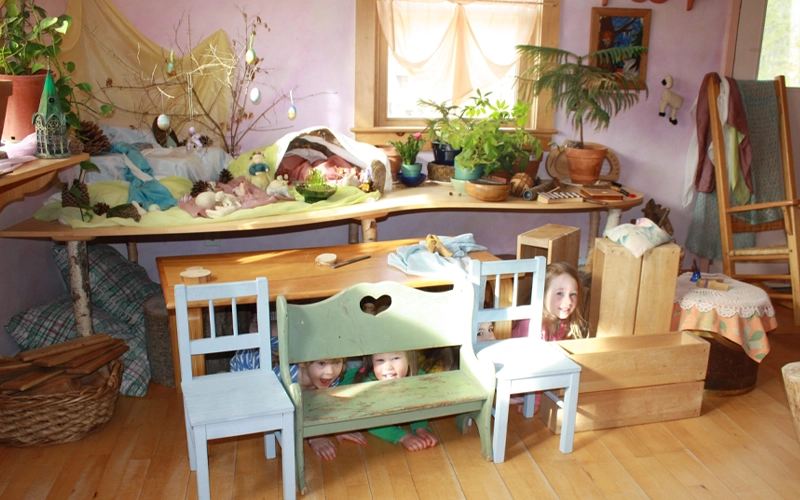
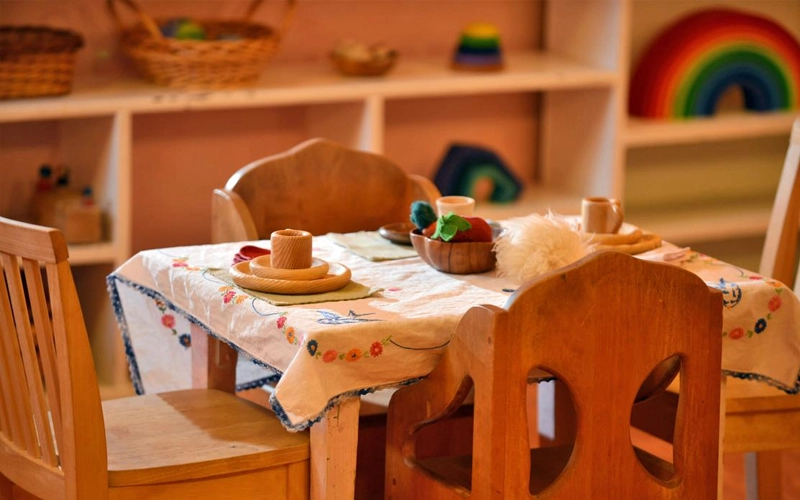
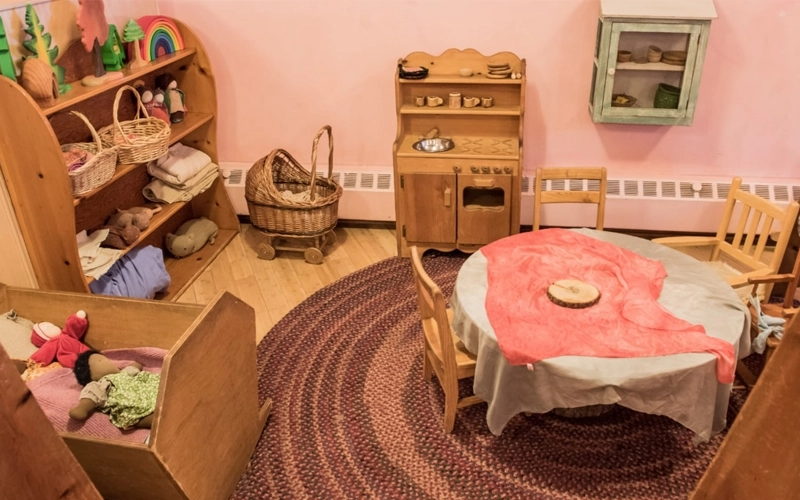
Designing Open-Ended Play and Learning Areas
A key feature of the Waldorf Teaching Method is making room for open-ended play and hands-on exploration. In Waldorf classrooms, teachers use thoughtful layouts and versatile products to encourage imagination and social growth.
- Flexible Spaces for Imaginative Play:
Waldorf schools make great use of play stands, which can become a shop, theater, or cozy hideaway with just a few silk scarves or pieces of fabric. Wooden building blocks, stacking crates, and simple tables let children design their play worlds. - Simple, Multi-Use Materials:
Toys and props in Waldorf classrooms are chosen for their versatility. Waldorf dolls, wooden animals, woven baskets, felt mats, and silk scarves allow kids to invent their own stories, build scenery, and explore movement. This supports the Waldorf philosophy of learning through doing. - No Screens or Battery Toys:
Following Waldorf’s pedagogy, there are no electronic gadgets in the classroom. Instead, children engage deeply with wooden puzzles, nature-inspired objects, and creative craft supplies. - Zones for Different Activities:
Spaces are set up for a variety of uses—a reading corner with floor cushions and a low bookshelf, a building area with tree slices and baskets of loose parts, an art table with paints and clay, and a puppet stage for storytelling. - Encouraging Social and Emotional Growth:
With these open-ended resources, children naturally learn to cooperate, share, and communicate, which is a hallmark of Waldorf education.
Typical Waldorf Play & Learning Products:
| منتج | Use in Classroom |
|---|---|
| Play Stands | Building forts, shops, puppet theaters |
| Wooden Building Blocks | Creative construction, counting, and sorting |
| Silk Scarves & Fabrics | Costumes, movement, scenery for imaginative play |
| Waldorf Dolls & Puppets | Storytelling, role play, social learning |
| Woven Baskets | Storing toys, natural objects, or art supplies |
| Floor Cushions & Rugs | Cozy areas for reading, resting, or circle time |
| Art Easels & Craft Tables | Painting, drawing, collaborative projects |
| Low Shelves & Bookcases | Accessible storage, book display for kids |
| Tree Slices & Loose Parts | Building, stacking, nature-based exploration |
These open-ended products help bring the Waldorf Teaching Method to life, turning any classroom into a place where creativity, independence, and discovery are part of everyday life.
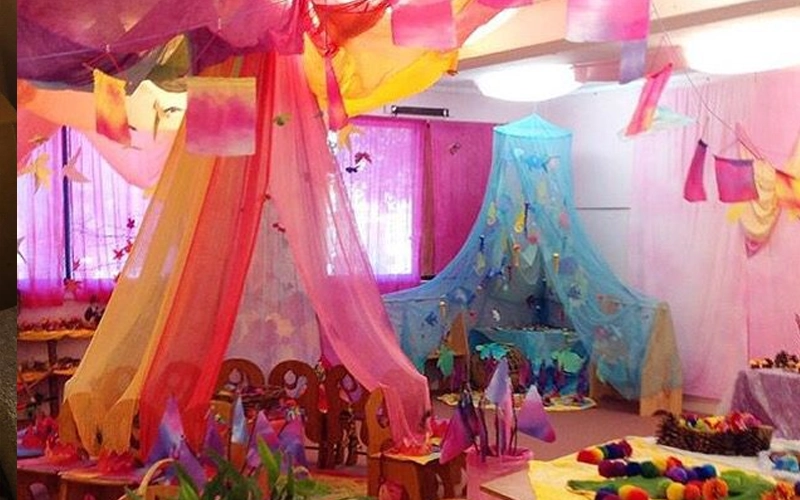
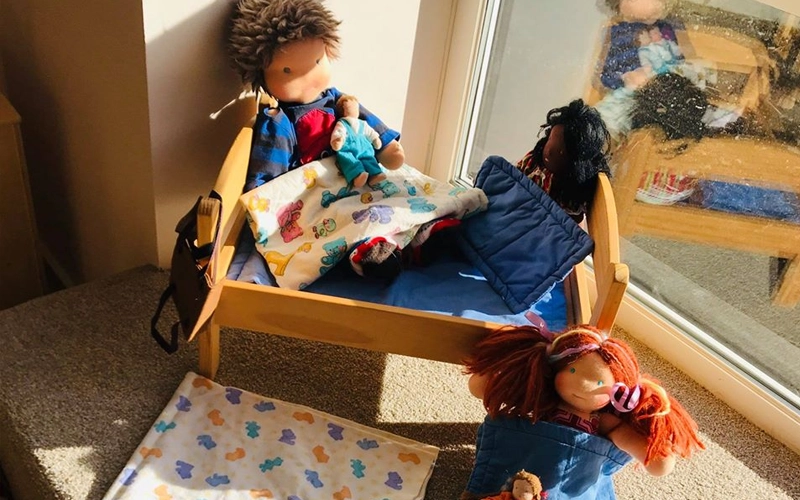

Bringing Nature and Seasonal Rhythm Into the Classroom
The Waldorf Teaching Method places a strong focus on connecting children with nature and honoring the rhythm of the seasons. In a Waldorf classroom, the environment is carefully designed to reflect the cycles of the natural world, a core part of Waldorf pedagogy and philosophy.
- Nature Tables and Seasonal Displays:
In Waldorf schools and Waldorf education preschools, a nature table is a central feature. Children collect and display seasonal items like stones, leaves, and flowers, turning the classroom into a living reflection of nature’s changes. This hands-on activity is a hallmark of the Waldorf Teaching Method and supports the Waldorf learning approach by encouraging observation and respect for the earth. - Maximizing Natural Light and Plant Life:
A typical Waldorf classroom is filled with sunlight and fresh air, supporting children’s well-being and learning. Plants and indoor gardens are common in Waldorf education schools, helping students learn to care for living things. Teachers in Waldorf schools may use window crystals or sun catchers to bring natural colors and beauty into the space. - Seasonal Crafts and Natural Decorations:
The Waldorf curriculum includes many handcrafts using wool, felt, and wood. Children create decorations and art projects that celebrate each season, such as spring garlands or autumn mobiles. This creative activity is central to Waldorf methodology and helps build the rhythm of the Waldorf classroom. - Outdoor Learning and Nature Walks:
The Waldorf approach encourages regular time outside, whether in a school garden or on nature walks. These experiences are deeply integrated into the Waldorf education system, helping children learn through direct experience and reinforcing the values of the Waldorf Teaching Method. - Daily and Weekly Rhythms:
Teachers following the Waldorf education philosophy plan routines and seasonal festivals in sync with the rhythms of nature. Morning circles, weekly baking, and seasonal celebrations are all classic examples of the Waldorf system in action.
In every Waldorf classroom, these natural elements and rhythms make learning come alive. The Waldorf Teaching Method teaches children to notice the world around them and feel part of something greater—an essential part of Waldorf education’s unique characteristics.
فصلك الدراسي المثالي على بعد نقرة واحدة!
Supporting Independence and Creativity Through Layout
A key goal of the Waldorf Teaching Method is to help children become independent thinkers and creative problem solvers. The way a Waldorf classroom is arranged can make a big difference in supporting both independence and creativity for every child.
- Accessible Furniture and Materials:
In Waldorf schools, all tables, chairs, shelves, and storage units are set at a child-friendly height. This encourages children to find what they need, tidy up after activities, and make their own choices throughout the day. The Waldorf classroom is designed to empower children and promote self-confidence, which is a core principle of the Waldorf education philosophy. - Open Layouts for Free Movement:
The Waldorf Teaching Method recommends open floor plans with clear pathways. Furniture is arranged so children can move freely between activity zones, such as play areas, reading corners, and art tables. This freedom supports creative exploration, collaboration, and physical coordination, all of which are valued in Waldorf pedagogy. - Choice and Flexibility:
The Waldorf approach allows children to choose where and how they work or play. Having multiple spaces—like a quiet corner for reading, a large table for group art, or an open area for building—lets students follow their interests and express their individuality. This supports the unique characteristics of the Waldorf learning method. - Self-Directed Activities:
Teachers using the Waldorf education model encourage self-initiated projects and open-ended tasks. Materials are displayed in an organized and inviting way so children can start activities on their own and clean up when finished. This routine helps students develop responsibility and a sense of ownership in the classroom. - Encouraging Collaboration:
While independence is key, the layout also fosters teamwork. Group seating, shared materials, and open spaces for circle time or performances give students the chance to work together, share ideas, and solve problems collectively—a central aspect of the Waldorf education system.
With a thoughtful classroom layout, the Waldorf Teaching Method creates an environment where children develop life skills, self-motivation, and creative confidence—qualities that last far beyond the preschool years.
Integrating Outdoor Learning Areas
In the Waldorf Teaching Method, learning doesn’t end at the classroom door. Outdoor spaces are seen as vital extensions of the Waldorf school environment, offering children fresh air, movement, and endless opportunities to connect with nature.
- Design Outdoor Classrooms with Nature in Mind
Waldorf education schools often create garden areas, sand pits, or quiet corners outdoors. Use natural materials—like wooden benches, tree stumps for seating, or bamboo fencing—to keep the outdoor space in harmony with the Waldorf philosophy. - Plan for Seasonal Activities
Schedule time for nature walks, gardening, and seasonal celebrations. Children might plant bulbs in the spring, gather leaves in the fall, or build snow forts in the winter. Outdoor learning supports the rhythm and sensory experiences that are so important in Waldorf pedagogy. - Provide Open-Ended Play Materials Outside
Offer loose parts such as logs, rocks, branches, and ropes for building and exploring. Avoid plastic playground equipment—natural elements fit better with the Waldorf approach and encourage creativity. - Create Sheltered Spaces
Include a shaded area or a simple outdoor shelter so children can learn and play outside in all weather. Outdoor chalkboards, low tables, and nature art stations add variety to outdoor lessons. - Support Exploration and Independence
Outdoor learning in Waldorf education is about giving children the freedom to explore. Safe boundaries, visible teachers, and simple ground rules allow kids to take risks and learn at their own pace. - Extend the Waldorf Curriculum Outdoors
Many Waldorf schools bring indoor routines outdoors—morning circle, storytelling, painting, and even snack time can happen outside. This extension reinforces the unique characteristics of the Waldorf Teaching Method.
Thoughtfully integrating outdoor learning areas will help children thrive, support whole-child development, and truly bring the Waldorf Teaching Method to life in your school or preschool.
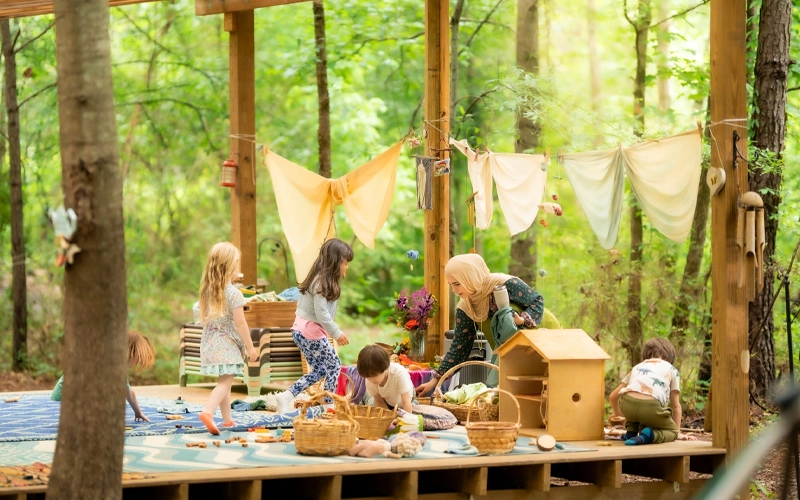
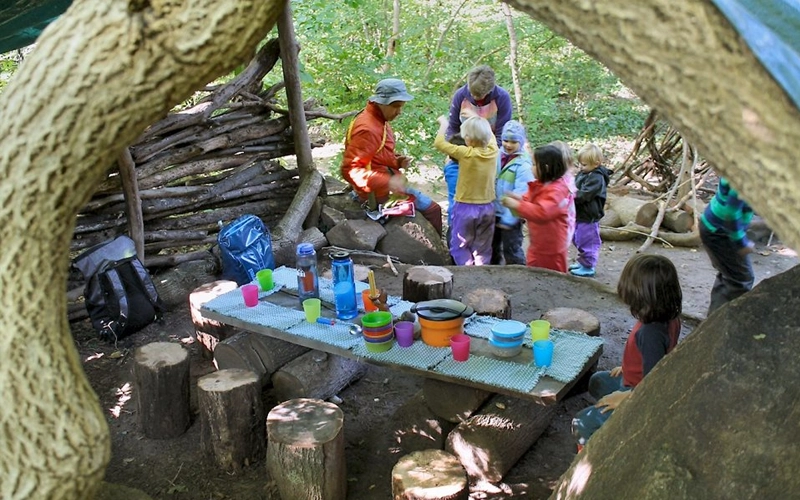
Practical Tips for Setting Up a Waldorf-Inspired Classroom
Setting up a Waldorf classroom requires more than just choosing beautiful furniture. The Waldorf Teaching Method is all about creating an environment that supports each child’s growth—mind, body, and spirit. Here are some practical suggestions for anyone preparing a Waldorf education classroom or preschool:
- Start with a Clear Plan:
Before bringing in any furniture, decide how the Waldorf classroom will be used throughout the day. Consider daily and seasonal rhythms, group activities, quiet corners, and space for movement. Waldorf’s pedagogy values flexibility and flow. - Prioritize Natural Materials:
Select solid wood tables and chairs, cotton or wool rugs, and natural fiber curtains. These materials help make the Waldorf school environment calm, welcoming, and healthy. Avoid plastic or metal when possible to stay true to the Waldorf education philosophy. - Create Defined Zones:
Use shelves and furniture to organize the classroom into areas for play, art, reading, and group work. In the Waldorf Teaching Method, having clear zones supports the unique characteristics of the Waldorf learning method. - Keep Decor Simple and Rhythmic:
Avoid clutter and bold decorations. Instead, display seasonal crafts, nature tables, and soft colors. The Waldorf approach believes that visual rhythm helps children feel secure and inspired. - Use Child-Sized Furniture and Open Storage:
Low tables, chairs, and shelves give children independence. They can reach materials on their own, which is central to Waldorf education schools and the Waldorf teaching philosophy. - Plan for Movement:
Include enough open floor space for circle time, games, and creative activities. The Waldorf education method encourages movement as part of daily routines. - Make Maintenance Easy:
Choose washable covers, sturdy furniture, and storage baskets to keep the classroom organized and clean. The Waldorf Teaching Method values beauty, but it must be practical for busy teachers and active children. - Consult Waldorf Furniture Suppliers:
When in doubt, reach out to suppliers who understand the Waldorf system and can recommend products that fit your vision and the Waldorf curriculum.
Setting up a Waldorf-inspired classroom is an investment in every child’s future. When you use the Waldorf Teaching Method to guide your choices, you create a space where children can thrive, just as Rudolf Steiner and Waldorf schools intended.
Step-by-Step Guide: Setting Up a Waldorf Classroom
Setting up a Waldorf classroom can seem overwhelming at first, but following a straightforward step-by-step process makes it both simple and effective. The Waldorf Teaching Method emphasizes thoughtful planning, natural materials, and flexibility. Here’s a practical guide to help you create a warm and inspiring Waldorf classroom from the ground up:
Step 1: Define the Classroom Purpose and Daily Rhythm
- Decide if the space will be for a Waldorf preschool, kindergarten, or elementary class.
- Sketch out your daily and weekly rhythm, including time for free play, circle time, art, storytelling, and outdoor activities.
- The Waldorf education philosophy values routines and transitions that help children feel secure.
Step 2: Choose a Calm, Light-Filled Space
- Whenever possible, select a room with natural sunlight and good airflow.
- Soft wall colors and simple window coverings support the welcoming Waldorf classroom atmosphere.
- Arrange furniture to take advantage of natural light, and consider adding plants or window crystals.
Step 3: Select Natural, Child-Sized Furniture
- Invest in solid wood tables, child-sized chairs, open shelving, and storage baskets.
- Keep pathways clear and make sure every child can reach supplies independently, following Waldorf pedagogy and supporting independence.
- Place reading corners, art tables, and nature tables where children naturally gather.
Step 4: Organize Activity Zones
- Use shelves or rugs to define zones for building, reading, art, music, and imaginative play.
- Make each area flexible so it can change as children’s interests and classroom needs shift.
- The Waldorf learning method encourages variety—don’t overcrowd, but leave space for movement and discovery.
Step 5: Add Open-Ended Play Materials and Seasonal Decorations
- Include play stands, wooden blocks, silk scarves, Waldorf dolls, and craft supplies.
- Rotate materials and update nature tables or seasonal displays throughout the year to reflect changes in nature.
- The Waldorf approach values beauty and rhythm, so display children’s artwork and handmade decorations.
Step 6: Maintain a Tidy, Organized Space
- Teach children to care for the classroom by putting things away after use.
- Use baskets, trays, and labeled shelves for easy access and clean-up.
- An orderly environment supports the unique characteristics of the Waldorf classroom and the Waldorf Teaching Method.
Step 7: Create a Welcoming Entry and Communicate with Families
- Set up a friendly entrance with a coat rack, shoe shelf, and space for parent communication.
- Display a daily schedule, upcoming events, and seasonal news for families to see.
- The Waldorf education system encourages strong home-school partnerships.
Quick Tips:
- Start simple and build as you go—every Waldorf classroom evolves.
- Involve teachers, children, and parents in decorating and maintaining the space.
- Reach out to Waldorf furniture suppliers for customized solutions that meet your needs.
With careful planning and an open mind, anyone can use the Waldorf Teaching Method to create a classroom where children feel inspired, valued, and ready to learn every day.
لا تحلم فقط، بل صممه! دعنا نتحدث عن احتياجاتك من الأثاث المخصص!
Common Mistakes to Avoid in Waldorf Classroom Setup
Setting up a Waldorf classroom can be both exciting and challenging. The Waldorf Teaching Method is unique and even experienced teachers or school leaders can make mistakes if they’re new to Waldorf education. Here are some of the most common pitfalls to avoid:
- Using Too Many Commercial or Plastic Materials
One of the biggest mistakes in Waldorf schools is filling the classroom with brightly colored plastic toys and commercial products. The Waldorf philosophy values natural, simple materials that spark the imagination. Always choose wood, cotton, wool, and other natural fibers for classroom furniture and learning materials. - Overcrowding the Space
Trying to fit in too much furniture or too many toys can make the classroom feel cluttered and overwhelming. The Waldorf approach believes in “less is more.” Keep open spaces for movement and free play, and rotate toys and supplies throughout the year instead of displaying everything at once. - Ignoring Rhythm and Routine
Waldorf classrooms need a steady rhythm to help children feel safe and focused. Skipping daily or seasonal routines can make students anxious and disrupt the Waldorf learning method. Plan for regular circle time, storytelling, seasonal crafts, and transitions. - Forgetting the Importance of Nature
Another common mistake is not bringing enough of the natural world into the classroom. An actual Waldorf classroom should reflect the seasons, with nature tables, plants, and seasonal decorations as core features of the Waldorf Teaching Method. - Neglecting Teacher and Student Comfort
Don’t overlook the comfort of teachers and children. Child-sized furniture, soft lighting, and cozy reading areas help everyone feel at home, which is vital for the Waldorf education philosophy. - Skipping Consultation with Experts
Sometimes, schools try to “DIY” a Waldorf setup without consulting those familiar with Waldorf pedagogy. This can lead to poor layout choices or the purchasing of unsuitable products. Work with experienced Waldorf furniture suppliers and educators whenever possible. - Lack of Flexibility
Sticking too rigidly to a room layout or over-planning can limit creativity and natural flow. The Waldorf classroom should evolve as the children grow and change—be ready to adapt your setup as needed.
Avoiding these mistakes helps ensure your Waldorf classroom is a welcoming, creative, and nurturing environment that genuinely supports the Waldorf Teaching Method.
كيفية دمج منهج والدورف في برنامج ما قبل المدرسة الخاص بك؟
إذا كنت تفكر في إدخال أسلوب تعليم والدورف في مرحلة ما قبل المدرسة، فهناك عدة خطوات حيوية يجب اتباعها لتتوافق مع مبادئ أسلوب تعليم والدورف.
إنشاء جدول زمني متسق
تشتهر فصول والدورف بجداولها الدراسية المنظمة والمرنة. يمنح الإيقاع اليومي المنتظم الأطفال شعورًا بالأمان ويساعدهم على الانتقال بسلاسة بين الأنشطة. ينبغي دمج أنشطة مثل وقت التجمع، ورواية القصص، والمهام العملية كالخبز أو البستنة في اليوم الدراسي لخلق تجربة تعليمية متوازنة وجذابة.
تُولي طريقة والدورف التعليمية أهمية كبيرة للإيقاع والروتين. في روضة والدورف، يتبع الأطفال جدولًا زمنيًا ثابتًا ومنتظمًا يتضمن وقتًا للعب الإبداعي، والمهام العملية، والأنشطة الفنية، والتأمل الهادئ. يُشعر هذا الإيقاع الأطفال بالأمان والثبات، ويوفر لهم أساسًا متينًا للتعلم والنمو الشخصي.
أضف ألعابًا وأثاثًا طبيعيًا
تُركّز فلسفة والدورف التعليمية بشكل كبير على استخدام المواد الطبيعية. فصول والدورف الدراسية مليئة بالأثاث الخشبي، والدمى المصنوعة يدويًا، والألياف الطبيعية كالصوف والقطن. تُساعد بساطة هذه المواد على تقليل التحفيز المفرط، وتُشجّع الأطفال على الانخراط بشكل أعمق في اللعب الإبداعي.
في روضة والدورف، تُعدّ البيئة المحيطة بالغة الأهمية لعملية التعلم. يوصي منهج والدورف باستخدام ألعاب مصنوعة من مواد طبيعية، تتميز بملمسها البسيط وبساطتها وتنوعها، مما يتيح للأطفال استكشاف مخيلتهم واستخدامها بحرية. تجنب الألعاب البلاستيكية أو التجارية التي قد تُحدد طريقة اللعب. استخدم بدلاً من ذلك ألعابًا تُمكّن الأطفال من المشاركة في اللعب التخيلي ورواية القصص والتعاون مع أقرانهم.
تشجيع مهارات الحياة العملية
إن دمج مهارات الحياة كالطبخ والتنظيف والأشغال اليدوية في منهج والدورف يُمكّن الأطفال من تنمية المسؤولية والاستقلالية والمهارات الحركية الدقيقة. هذه الأنشطة ليست مجرد أعمال منزلية، بل هي تجارب تعليمية تُعزز الشعور بالإنجاز والانتماء للمجتمع.
تعتبر طريقة والدورف التعليمية هذه المهام العملية أساسية لنمو الطفل. في صف والدورف، قد يساعد الأطفال في تحضير الوجبات الخفيفة، أو تجهيز الغرفة لأنشطة اليوم، أو المساعدة في الترتيب بعد وقت اللعب. تُعلّم هذه الأنشطة مهارات حياتية أساسية، وتشجع على العمل الجماعي، وتمنح الأطفال شعورًا بالمسؤولية والانتماء ضمن مجتمع الصف.
استكشف الطبيعة مع الأطفال
يُعدّ اللعب في الهواء الطلق ركنًا أساسيًا في فلسفة تعليم والدورف. سواءً أكان نزهةً في الطبيعة، أو بستنةً، أو لعبًا حرًا في بيئة طبيعية، فإن هذه الأنشطة تُساعد الأطفال على بناء رابطٍ مع الطبيعة، وهو ركنٌ أساسيٌّ من تعليم والدورف. فالتعرض المُنتظم للطبيعة يُعزز لديهم الشعور بالدهشة والفضول والمسؤولية البيئية.
غالبًا ما تُدمج روضة والدورف أنشطة موسمية تعكس إيقاعات العالم الطبيعي، مثل زراعة البذور في الربيع، وجمع الأوراق في الخريف، أو بناء منحوتات ثلجية في الشتاء. تُشجع هذه الأنشطة الخارجية على النشاط البدني وتُعزز تقدير الأطفال للعالم من حولهم. يُعتبر العالم الطبيعي أفضل فصل دراسي في تعليم والدورف، إذ يُتيح فرصًا لا حصر لها للاستكشاف والتعلم.
كيف يختلف والدورف عن المدرسة العادية؟
يتميز تعليم والدورف عن المدارس التقليدية في عدة جوانب رئيسية، أبرزها نهجه التنموي، ومنهجية التعلم، وفلسفته العامة. وفيما يلي أوجه اختلاف مدارس والدورف عن المدارس التقليدية:
- هل يمكن تكييف طريقة والدورف مع الفصول الدراسية الحديثة؟
يُثني أسلوب فالدورف التعليمي عن استخدام التكنولوجيا، بينما تعتمد الفصول الدراسية الحديثة غالبًا على الأدوات الرقمية. ويُمثل تكييف مبادئ فالدورف لتلبية متطلبات المشهد التعليمي المعاصر تحديًا تواجهه العديد من المدارس. - هل طريقة والدورف مناسبة لجميع أنواع الأطفال؟
على الرغم من أن طريقة والدورف شاملة وتركز على الطفل، إلا أنها قد لا تنجح مع جميع الأطفال، وخاصة أولئك الذين يزدهرون في بيئة أكاديمية أكثر تنظيماً. - كيف تتعامل طريقة والدورف مع الفروق الفردية في التعلم؟
يتيح نظام والدورف التعليمي للأطفال التعلم بوتيرتهم الخاصة، مما يعزز الشمولية. ومع ذلك، فإن عدم وجود تقييمات موحدة قد لا يوفر دعمًا كافيًا للأطفال ذوي الاحتياجات التعليمية الخاصة.
غالبًا ما تجذب مدارس والدورف العائلات التي تُعطي الأولوية للإبداع والنمو العاطفي وبطء وتيرة التقديم الأكاديمي. ومع ذلك، يُجادل بعض النقاد بأن الأطفال في مدارس والدورف قد لا يكونون مُهيئين جيدًا للاختبارات المعيارية والصرامة الأكاديمية التي تُميز التعليم التقليدي. صُمم نظام والدورف التعليمي لتلبية احتياجات كل طفل، ولكنه قد لا يتماشى مع توقعات العائلات التي تسعى إلى تعليم تقليدي ومنظم.
خاتمة
إن دمج أسلوب والدورف التعليمي في رياض الأطفال يُتيح تجربة تعليمية ثرية، حيث ينمو الأطفال عاطفيًا وفكريًا واجتماعيًا. يُشجع أسلوب والدورف الإبداع والاستقلالية وحب التعلم مدى الحياة من خلال التركيز على التعلم العملي والتجريبي، وتعزيز التواصل مع الطبيعة.
بتبني فلسفة والدورف، يُمكنكم تهيئة بيئة مُغذية يُحقق فيها الأطفال النجاح الأكاديمي وفي جميع مجالات الحياة. تُوفر خصائص تعليم والدورف الفريدة بديلاً شاملاً مُركزاً على الطفل عن التعليم التقليدي، مُنشئاً أفراداً مُتكاملين وفضوليين مُستعدين لمواجهة تحديات المستقبل. يُعد نظام والدورف التعليمي مثالياً لتعزيز تجارب تعليمية عميقة وهادفة تدوم مدى الحياة، مما يجعل أسلوب والدورف التعليمي خياراً ممتازاً لمرحلة ما قبل المدرسة التي تسعى لتقديم شيء يتجاوز التعليم التقليدي.
بتبني أسلوب والدورف التعليمي ومواءمة برنامج ما قبل المدرسة مع مبادئه الأساسية، يمكنكِ خلق بيئة تعليمية غنية وجذابة تدعم النمو الشامل لكل طفل. تضمن هذه الطريقة إعداد الأطفال للمدرسة والحياة.
الأسئلة الشائعة
What is a Waldorf school’s main difference?
A Waldorf school follows the Waldorf Teaching Method, focusing on whole-child development through art, imagination, and nature-based activities, rather than early academic drills. This unique approach sets it apart from traditional education models.
Why are natural materials essential?
Waldorf education cherishes wood, wool, cotton, and other natural elements. These sensory-rich materials create calm classrooms that align with the core values of the Waldorf approach and support children’s emotional well-being.
When do children start learning formal academics?
In the Waldorf curriculum, formal reading and writing are introduced around age 7. Before that, children engage in storytelling, handicrafts, and rhythmic play, laying a strong foundation without early academic pressure.
Do Waldorf classrooms include outdoor time?
Yes—outdoor learning is a staple of Waldorf schools. Activities include gardening, nature walks, and seasonal festivals, extending the Waldorf pedagogy beyond the classroom walls.
How can layout support independence?
A well-designed layout includes child-height shelves, open play areas, and flexible seating. This empowers children to access materials, collaborate, and self-direct—key features of the Waldorf education philosophy.
How do I avoid overcrowding a Waldorf classroom?
Stick to simple, open-ended furniture like wooden tables and open shelving, rotate materials over time, and leave enough space for movement. This minimalist “less is more” design honors Waldorf methodology and enhances creativity.

